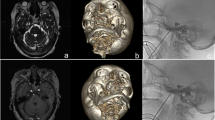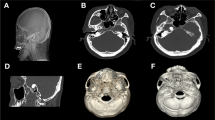Abstract
Percutaneous balloon compression is a surgical method for the treatment of trigeminal neuralgia, but one of the surgical parameters, compression time, is inconclusive. To investigate the effect of compression time during balloon compression on long-term postoperative hypoesthesia in patients with primary trigeminal neuralgia and to provide guidance on relevant parameters for balloon compression in the treatment of primary trigeminal neuralgia, we conducted a nested case–control study. Patients with primary trigeminal neuralgia treated by balloon compression from March 2013 to September 2013 were divided into case group and control group according to whether there were still symptoms of hypoesthesia at present. The relationship between the compression time of balloon compression and long-term hypoesthesia was analyzed. A total of 289 trigeminal neuralgia patients treated with percutaneous balloon compression were included in this study. Multivariate logistic regression showed that compression time was significantly correlated with long-term hypoesthesia (OR = 1.91, 95% CI = 1.13–3.23, P = 0.02), and compression time was greater than one. The risk of hypoesthesia in the long-term when the compression time is longer than 1 min is 1.93 times that of 1 min. PBC is a safe and effective surgical method, and the long-term hypoesthesia is related to the compression time during operation. The longer the compression time during operation, the greater the risk of long-term hypoesthesia.
Similar content being viewed by others
Data availability
Considering the privacy of patients, the data cannot be shared publicly. The data will be shared on reasonable request to the corresponding author.
References
Society IH (2018) Headache Classification Committee of the International Headache Society (IHS) The international classification of headache disorders, 3rd edition. Cephalalgia. 38(1):1–211. https://doi.org/10.1177/0333102417738202
De Cordoba JL, Garcia Bach M, Isach N, Piles S (2015) Percutaneous balloon compression for trigeminal neuralgia: imaging and technical aspects. Reg Anesth Pain Med 40(5):616–622. https://doi.org/10.1097/AAP.0000000000000292
Bendtsen L, Zakrzewska JM, Abbott J, Braschinsky M, Di Stefano G, Donnet A et al (2019) European Academy of Neurology guideline on trigeminal neuralgia. Eur J Neurol 26(6):831–849. https://doi.org/10.1111/ene.13950
Araya EI, Claudino RF, Piovesan EJ, Chichorro JG (2020) Trigeminal neuralgia: basic and clinical aspects. Curr Neuropharmacol 18(2):109–119. https://doi.org/10.2174/1570159X17666191010094350
Mullan S, Lichtor T (1983) Percutaneous microcompression of the trigeminal ganglion for trigeminal neuralgia. J Neurosurg 59(6):1007–1012. https://doi.org/10.3171/jns.1983.59.6.1007
Asplund P, Blomstedt P, Bergenheim AT (2016) Percutaneous balloon compression vs percutaneous retrogasserian glycerol rhizotomy for the primary treatment of trigeminal neuralgia. Neurosurgery 78(3):421–8. https://doi.org/10.1227/NEU.0000000000001059. (discussion 8)
Lichtor T, Mullan JF (1990) A 10-year follow-up review of percutaneous microcompression of the trigeminal ganglion. J Neurosurg 72(1):49–54. https://doi.org/10.3171/jns.1990.72.1.0049
Lee ST, Chen JF (2003) Percutaneous trigeminal ganglion balloon compression for treatment of trigeminal neuralgia, part II: results related to compression duration. Surg Neurol 60(2):149–53. https://doi.org/10.1016/s0090-3019(03)00253-2. (discussion 53-4)
Park SS, Lee MK, Kim JW, Jung JY, Kim IS, Ghang CG (2008) Percutaneous balloon compression of trigeminal ganglion for the treatment of idiopathic trigeminal neuralgia: experience in 50 patients. J Korean Neurosurg Soc 43(4):186–189. https://doi.org/10.3340/jkns.2008.43.4.186
Kourilsky A, Palpacuer C, Rogers A, Chauvet D, Wiart C, Bourdillon P, et al. (2022) Multivariate models to predict pain recurrence and sensitive complications after percutaneous balloon compression in trigeminal neuralgia. J Neurosurg 1–10. https://doi.org/10.3171/2022.2.Jns212644
Li MW, Jiang XF, Niu CS (2021) Efficacy of and risk factors for percutaneous balloon compression for trigeminal neuralgia in elderly patients. Br J Neurosurg 35(3):280–284. https://doi.org/10.1080/02688697.2020.1787341
Li F, Han S, Ma Y, Yi F, Xu X, Liu Y (2014) Optimal duration of percutaneous microballoon compression for treatment of trigeminal nerve injury. Neural Regen Res 9(2):179–189. https://doi.org/10.4103/1673-5374.125347
Love S, Coakham HB (2001) Trigeminal neuralgia: pathology and pathogenesis. Brain 124(Pt 12):2347–2360. https://doi.org/10.1093/brain/124.12.2347
Broggi G (2013) Percutaneous retrogasserian balloon compression for trigeminal neuralgia. World Neurosurg 79(2):269–270. https://doi.org/10.1016/j.wneu.2012.05.015
Lv W, Hu W, Chi L, Zhang L (2022) Factors that may delay disappearance of trigeminal neuralgia after percutaneous balloon compression. Neurol Neurochir Pol 56(2):156–162. https://doi.org/10.5603/PJNNS.a2022.0017
Wang H, Chen C, Chen D, Li F, Hu S, Ding W et al (2022) Clinical analysis of the treatment of primary trigeminal neuralgia by percutaneous balloon compression. Front Surg 9:843982. https://doi.org/10.3389/fsurg.2022.843982
Fan X, Xu F, Ren H, Lu Z, Bu H, Ma L et al (2021) The analysis of percutaneous balloon compression on efficacy and negative emotion in the treatment of recurrent trigeminal neuralgia after surgical procedures. Pain Physician 24(8):E1255–E1262
Ying X, Wang H, Deng S, Chen Y, Zhang J, Yu W (2017) Long-term outcome of percutaneous balloon compression for trigeminal neuralgia patients elder than 80 years: a STROBE-compliant article. Medicine (Baltimore) 96(39):e8199. https://doi.org/10.1097/MD.0000000000008199
Chen JF, Tu PH, Lee ST (2011) Long-term follow-up of patients treated with percutaneous balloon compression for trigeminal neuralgia in Taiwan. World Neurosurg 76(6):586–591. https://doi.org/10.1016/j.wneu.2011.05.021
Zheng S, Yuan R, Ni J, Liu H, Yang Y, Zhang S et al (2022) Long-term recurrence-free survival and complications of percutaneous balloon compression and radiofrequency thermocoagulation of Gasserian ganglion for trigeminal neuralgia: a retrospective study of 1313 cases. Pain Pract 22(5):532–540. https://doi.org/10.1111/papr.13114
Asplund P, Linderoth B, Bergenheim AT (2010) The predictive power of balloon shape and change of sensory functions on outcome of percutaneous balloon compression for trigeminal neuralgia. J Neurosurg 113(3):498–507. https://doi.org/10.3171/2010.2.Jns091466
Correa CF, Teixeira MJ (1998) Balloon compression of the Gasserian ganglion for the treatment of trigeminal neuralgia. Stereotact Funct Neurosurg 71(2):83–89. https://doi.org/10.1159/000029651
Campos WK, Linhares MN (2011) A prospective study of 39 patients with trigeminal neuralgia treated with percutaneous balloon compression. Arq Neuropsiquiatr 69(2A):221–226. https://doi.org/10.1590/s0004-282x2011000200016
Noorani I, Lodge A, Durnford A, Vajramani G, Sparrow O (2021) Comparison of first-time microvascular decompression with percutaneous surgery for trigeminal neuralgia: long-term outcomes and prognostic factors. Acta Neurochir (Wien) 163(6):1623–1634. https://doi.org/10.1007/s00701-021-04793-4
Yadav S, Sonone RM, Jaiswara C, Bansal S, Singh D, Rathi VC (2016) Long-term follow-up of trigeminal neuralgia patients treated with percutaneous balloon compression technique: a retrospective analysis. J Contemp Dent Pract 17(3):263–266. https://doi.org/10.5005/jp-journals-10024-1838
Abdennebi B, Bouatta F, Chitti M, Bougatene B (1995) Percutaneous balloon compression of the Gasserian ganglion in trigeminal neuralgia. Long-term results in 150 cases. Acta neurochirurgica 136(1–2):72–4. https://doi.org/10.1007/bf01411438
Fraioli B, Esposito V, Guidetti B, Cruccu G, Manfredi M (1989) Treatment of trigeminal neuralgia by thermocoagulation, glycerolization, and percutaneous compression of the gasserian ganglion and/or retrogasserian rootlets: long-term results and therapeutic protocol. Neurosurgery 24(2):239–245. https://doi.org/10.1227/00006123-198902000-00014
Brown JA, Hoeflinger B, Long PB, Gunning WT, Rhoades R, Bennett-Clarke CA et al (1996) Axon and ganglion cell injury in rabbits after percutaneous trigeminal balloon compression. Neurosurgery 38(5):993–1003. https://doi.org/10.1097/00006123-199605000-00028. (discussion -4)
Wang JY, Bender MT, Bettegowda C (2016) Percutaneous procedures for the treatment of trigeminal neuralgia. Neurosurg Clin N Am 27(3):277–295. https://doi.org/10.1016/j.nec.2016.02.005
Lv W, Hu W, Chi L, Zhang L (2022) Factors that may affect recurrence of trigeminal neuralgia after percutaneous balloon compression. J Clin Neurosci 99:248–252. https://doi.org/10.1016/j.jocn.2022.03.022
Abdennebi B, Guenane L (2014) Technical considerations and outcome assessment in retrogasserian balloon compression for treatment of trigeminal neuralgia. Series of 901 patients. Surg Neurol Int 5:118. https://doi.org/10.4103/2152-7806.137838
Acknowledgements
We express our gratitude to participants and researchers in this study.
Author information
Authors and Affiliations
Contributions
All authors contributed to the study conception and design. The work was designed by Yanfeng Li, Haitao Huang, and Yi Ma. Material preparation and data collection were performed by Quancai Wang and Bin Wang. The interpretation of data was performed by Fangkun Jing and Yangxi Xu. The first draft of the manuscript was written by Bo Zhou and Qiu Xia, and all authors commented on the previous versions of the manuscript. All authors read and approved the final manuscript.
Corresponding authors
Ethics declarations
Ethical approval
This study was performed in line with the principles of the Declaration of Helsinki. All research procedures were approved by the Institutional Research Review Board and the Research Ethics Committee of The People’s Hospital of Liaoning Province (approval number: 2022HS005). Patient’s personal sensitive information has been anonymized and de-identified.
Competing interests
The authors declare no competing interests.
Additional information
Publisher's note
Springer Nature remains neutral with regard to jurisdictional claims in published maps and institutional affiliations.
Rights and permissions
Springer Nature or its licensor (e.g. a society or other partner) holds exclusive rights to this article under a publishing agreement with the author(s) or other rightsholder(s); author self-archiving of the accepted manuscript version of this article is solely governed by the terms of such publishing agreement and applicable law.
About this article
Cite this article
Xia, Q., Huang, H., Ma, Y. et al. Relationship between compression time and long-term hypoesthesia in primary trigeminal neuralgia treated with percutaneous balloon compression. Neurosurg Rev 46, 212 (2023). https://doi.org/10.1007/s10143-023-02124-y
Received:
Revised:
Accepted:
Published:
DOI: https://doi.org/10.1007/s10143-023-02124-y




